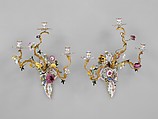Pair of wall lights
Manufactory Royal Porcelain Manufactory, Berlin German
Frederick the Great was an ardent champion of the Rococo style, which flourished in and around Berlin under his patronage. The northern German version of the Rococo was characterized by a pronounced asymmetry and exaggeration of form, a preference for a combination of rich materials, and the use of strong colors, qualities that distinguished the Rococo associated with Frederick's court from that of France and southern Germany. A specific characteristic of Frederick's Rococo taste was a prominent use of naturalistic, boldly sculptural flowers. Those that dominate the design of this pair of wall lights are a hallmark of the Royal Porcelain Manufactory, which Frederick established in 1763 on acquiring a struggling porcelain factory. The wall lights, among the most ambi- tious objects made at the new factory, are brilliantly conceived as a pair. The back plates are mirror images, and many of the same flowers appear on both wall lights, on one depicted with the blossoms open and on the other with them closed. Among the flowers are peonies, tulips, carnations, roses, and columbine, and their modeling, whether in low relief or in three dimensions, represents a tour de force of porcelain production in the eighteenth century.
Due to rights restrictions, this image cannot be enlarged, viewed at full screen, or downloaded.

